jump start FORD EXCURSION 2003 1.G Owners Manual
[x] Cancel search | Manufacturer: FORD, Model Year: 2003, Model line: EXCURSION, Model: FORD EXCURSION 2003 1.GPages: 240, PDF Size: 2.2 MB
Page 2 of 240
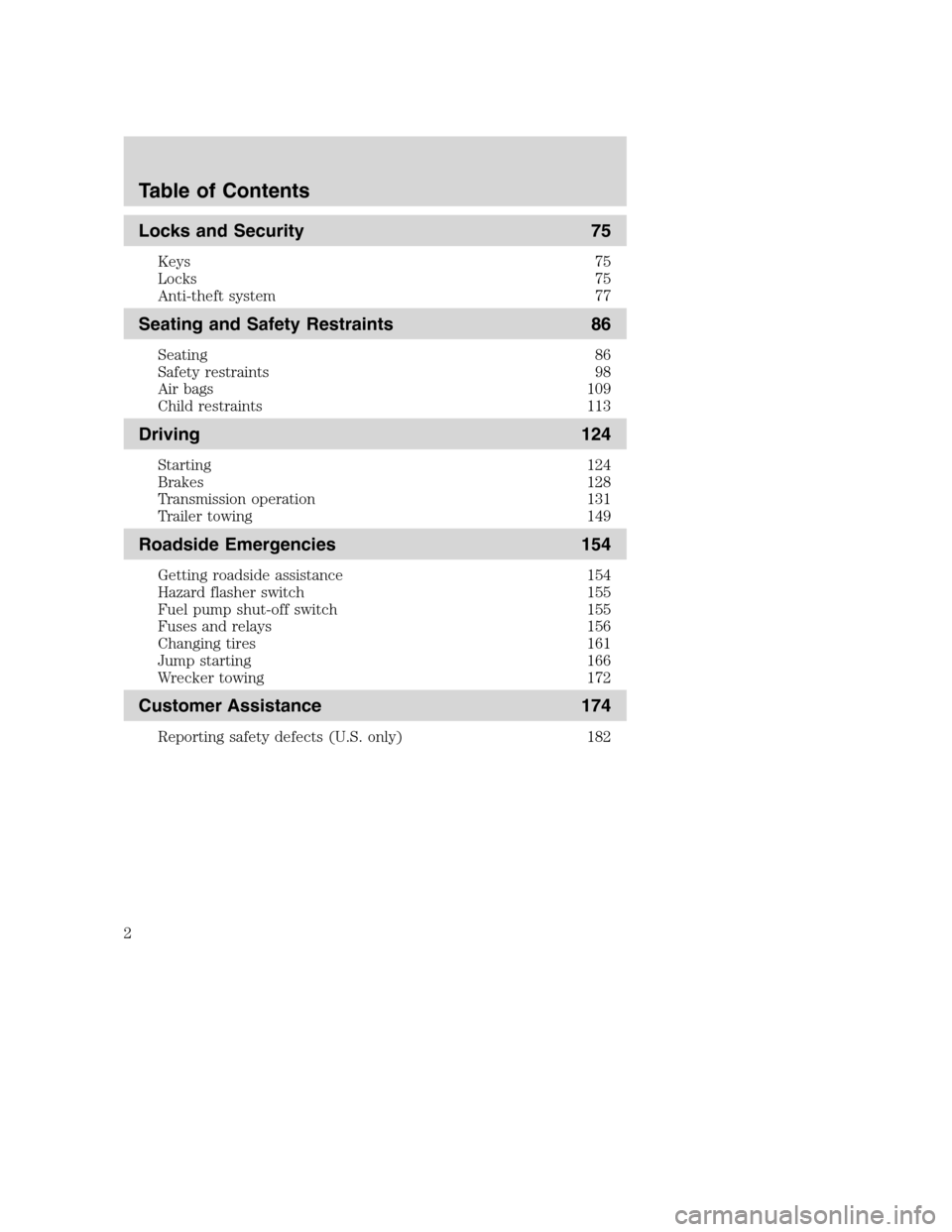
Locks and Security 75
Keys 75
Locks 75
Anti-theft system 77
Seating and Safety Restraints 86
Seating 86
Safety restraints 98
Air bags 109
Child restraints 113
Driving 124
Starting 124
Brakes 128
Transmission operation 131
Trailer towing 149
Roadside Emergencies 154
Getting roadside assistance 154
Hazard flasher switch 155
Fuel pump shut-off switch 155
Fuses and relays 156
Changing tires 161
Jump starting 166
Wrecker towing 172
Customer Assistance 174
Reporting safety defects (U.S. only) 182
Table of Contents
2
Page 154 of 240
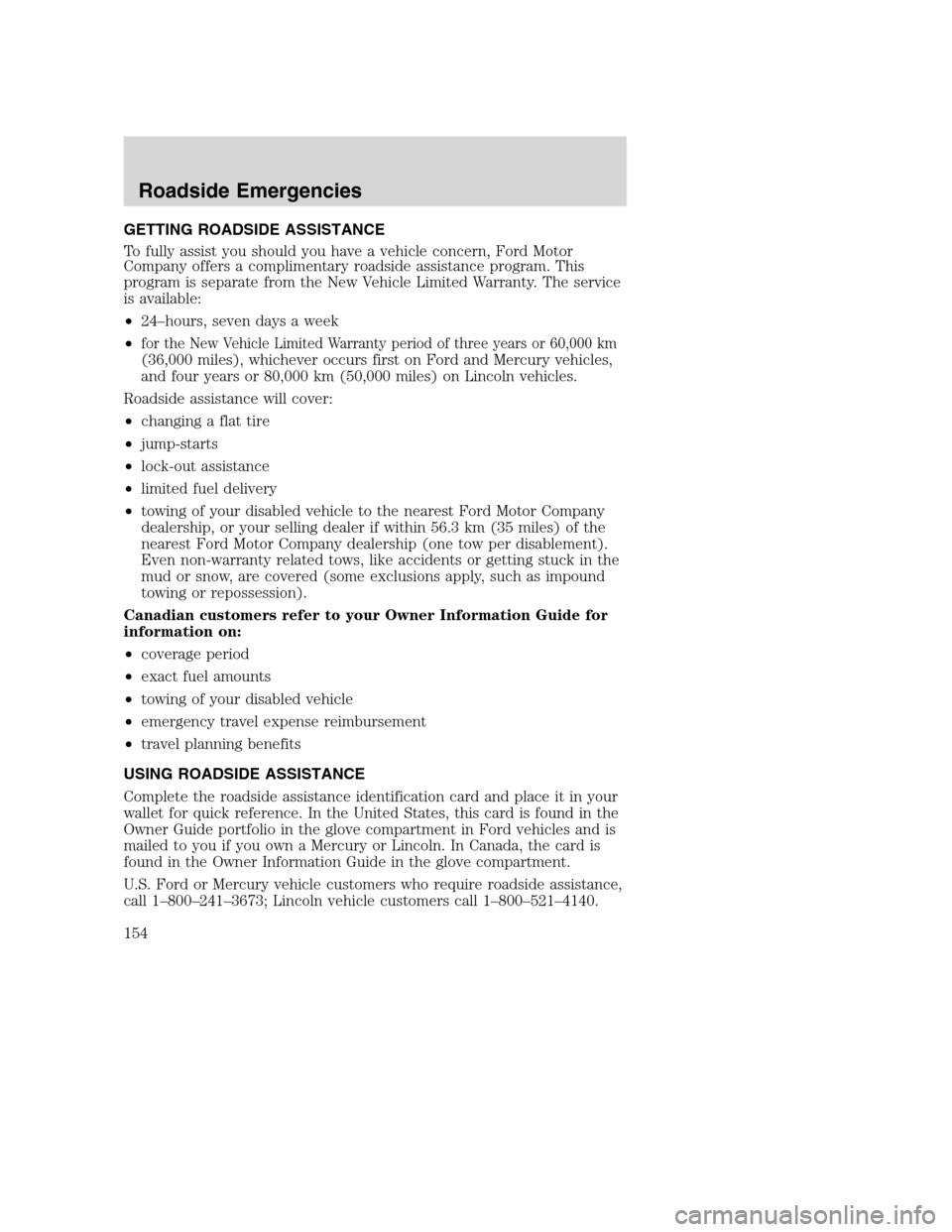
GETTING ROADSIDE ASSISTANCE
To fully assist you should you have a vehicle concern, Ford Motor
Company offers a complimentary roadside assistance program. This
program is separate from the New Vehicle Limited Warranty. The service
is available:
•24–hours, seven days a week
•
for the New Vehicle Limited Warranty period of three years or 60,000 km
(36,000 miles), whichever occurs first on Ford and Mercury vehicles,
and four years or 80,000 km (50,000 miles) on Lincoln vehicles.
Roadside assistance will cover:
•changing a flat tire
•jump-starts
•lock-out assistance
•limited fuel delivery
•towing of your disabled vehicle to the nearest Ford Motor Company
dealership, or your selling dealer if within 56.3 km (35 miles) of the
nearest Ford Motor Company dealership (one tow per disablement).
Even non-warranty related tows, like accidents or getting stuck in the
mud or snow, are covered (some exclusions apply, such as impound
towing or repossession).
Canadian customers refer to your Owner Information Guide for
information on:
•coverage period
•exact fuel amounts
•towing of your disabled vehicle
•emergency travel expense reimbursement
•travel planning benefits
USING ROADSIDE ASSISTANCE
Complete the roadside assistance identification card and place it in your
wallet for quick reference. In the United States, this card is found in the
Owner Guide portfolio in the glove compartment in Ford vehicles and is
mailed to you if you own a Mercury or Lincoln. In Canada, the card is
found in the Owner Information Guide in the glove compartment.
U.S. Ford or Mercury vehicle customers who require roadside assistance,
call 1–800–241–3673; Lincoln vehicle customers call 1–800–521–4140.
Roadside Emergencies
154
Page 166 of 240
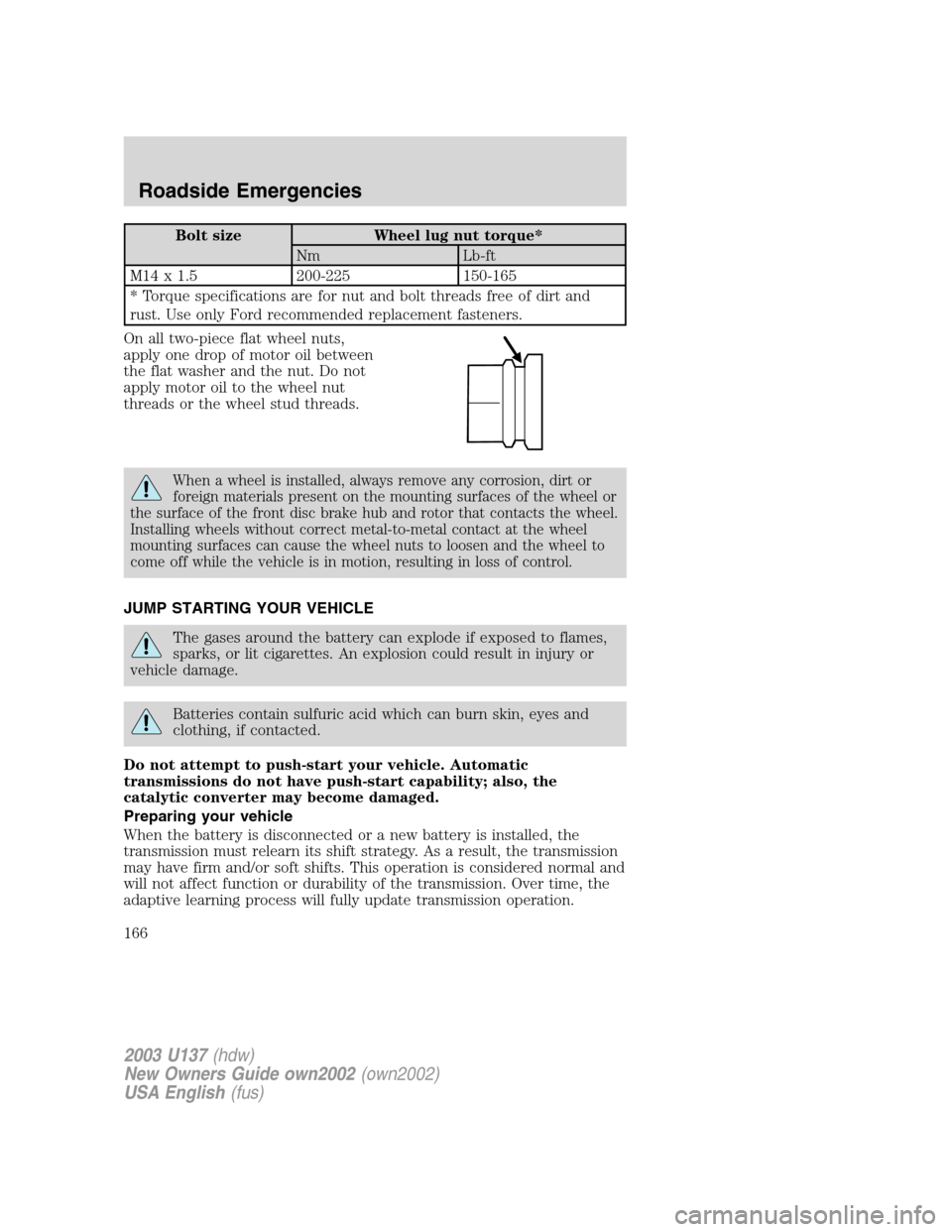
Bolt size Wheel lug nut torque*
Nm Lb-ft
M14 x 1.5 200-225 150-165
* Torque specifications are for nut and bolt threads free of dirt and
rust. Use only Ford recommended replacement fasteners.
On all two-piece flat wheel nuts,
apply one drop of motor oil between
the flat washer and the nut. Do not
apply motor oil to the wheel nut
threads or the wheel stud threads.
When a wheel is installed, always remove any corrosion, dirt or
foreign materials present on the mounting surfaces of the wheel or
the surface of the front disc brake hub and rotor that contacts the wheel.
Installing wheels without correct metal-to-metal contact at the wheel
mounting surfaces can cause the wheel nuts to loosen and the wheel to
come off while the vehicle is in motion, resulting in loss of control.
JUMP STARTING YOUR VEHICLE
The gases around the battery can explode if exposed to flames,
sparks, or lit cigarettes. An explosion could result in injury or
vehicle damage.
Batteries contain sulfuric acid which can burn skin, eyes and
clothing, if contacted.
Do not attempt to push-start your vehicle. Automatic
transmissions do not have push-start capability; also, the
catalytic converter may become damaged.
Preparing your vehicle
When the battery is disconnected or a new battery is installed, the
transmission must relearn its shift strategy. As a result, the transmission
may have firm and/or soft shifts. This operation is considered normal and
will not affect function or durability of the transmission. Over time, the
adaptive learning process will fully update transmission operation.
2003 U137(hdw)
New Owners Guide own2002(own2002)
USA English(fus)
Roadside Emergencies
166
Page 167 of 240
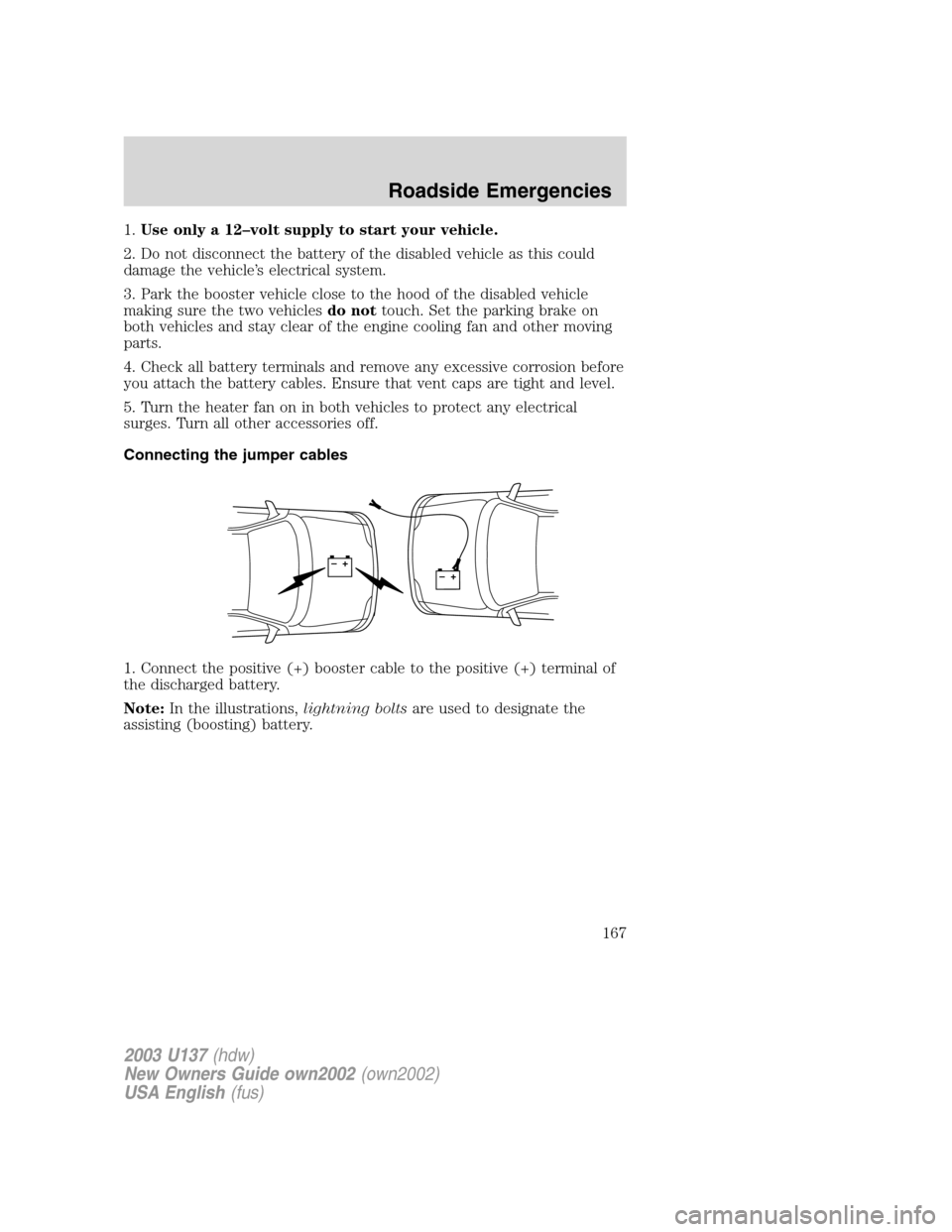
1.Use only a 12–volt supply to start your vehicle.
2. Do not disconnect the battery of the disabled vehicle as this could
damage the vehicle’s electrical system.
3. Park the booster vehicle close to the hood of the disabled vehicle
making sure the two vehiclesdo nottouch. Set the parking brake on
both vehicles and stay clear of the engine cooling fan and other moving
parts.
4. Check all battery terminals and remove any excessive corrosion before
you attach the battery cables. Ensure that vent caps are tight and level.
5. Turn the heater fan on in both vehicles to protect any electrical
surges. Turn all other accessories off.
Connecting the jumper cables
1. Connect the positive (+) booster cable to the positive (+) terminal of
the discharged battery.
Note:In the illustrations,lightning boltsare used to designate the
assisting (boosting) battery.
+–+–
2003 U137(hdw)
New Owners Guide own2002(own2002)
USA English(fus)
Roadside Emergencies
167
Page 169 of 240
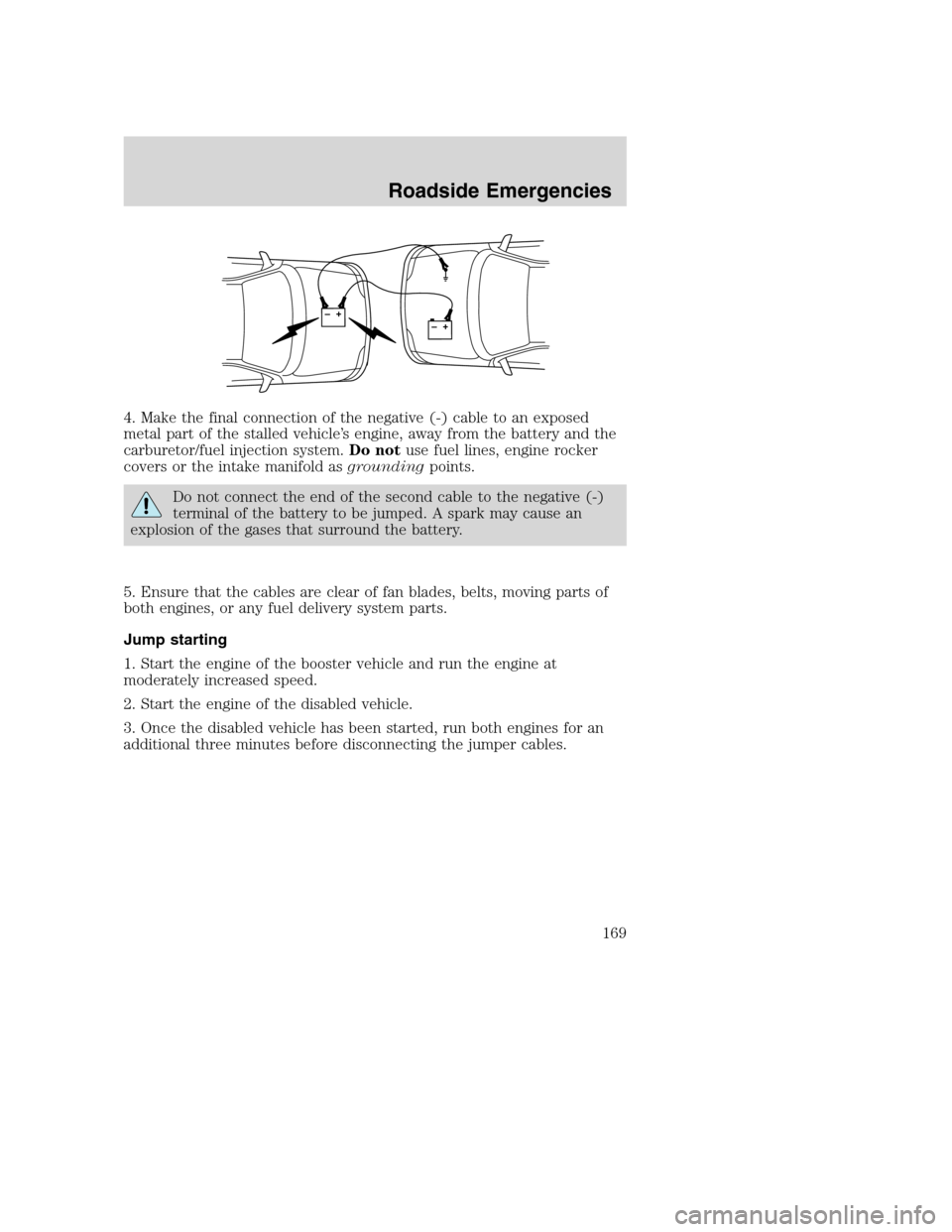
4. Make the final connection of the negative (-) cable to an exposed
metal part of the stalled vehicle’s engine, away from the battery and the
carburetor/fuel injection system.Do notuse fuel lines, engine rocker
covers or the intake manifold asgroundingpoints.
Do not connect the end of the second cable to the negative (-)
terminal of the battery to be jumped. A spark may cause an
explosion of the gases that surround the battery.
5. Ensure that the cables are clear of fan blades, belts, moving parts of
both engines, or any fuel delivery system parts.
Jump starting
1. Start the engine of the booster vehicle and run the engine at
moderately increased speed.
2. Start the engine of the disabled vehicle.
3. Once the disabled vehicle has been started, run both engines for an
additional three minutes before disconnecting the jumper cables.
+–+–
Roadside Emergencies
169
Page 171 of 240
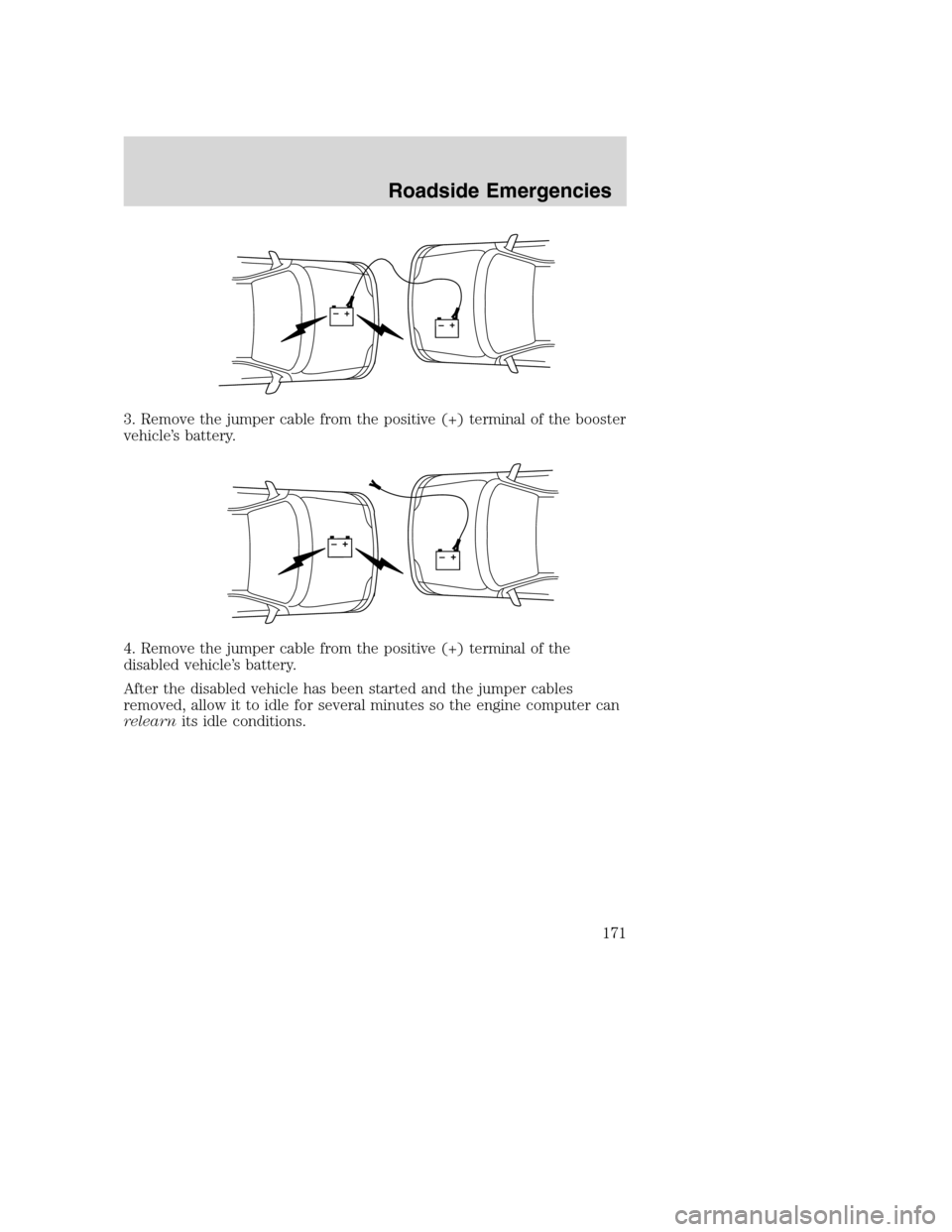
3. Remove the jumper cable from the positive (+) terminal of the booster
vehicle’s battery.
4. Remove the jumper cable from the positive (+) terminal of the
disabled vehicle’s battery.
After the disabled vehicle has been started and the jumper cables
removed, allow it to idle for several minutes so the engine computer can
relearnits idle conditions.
+–+–
+–+–
Roadside Emergencies
171
Page 236 of 240
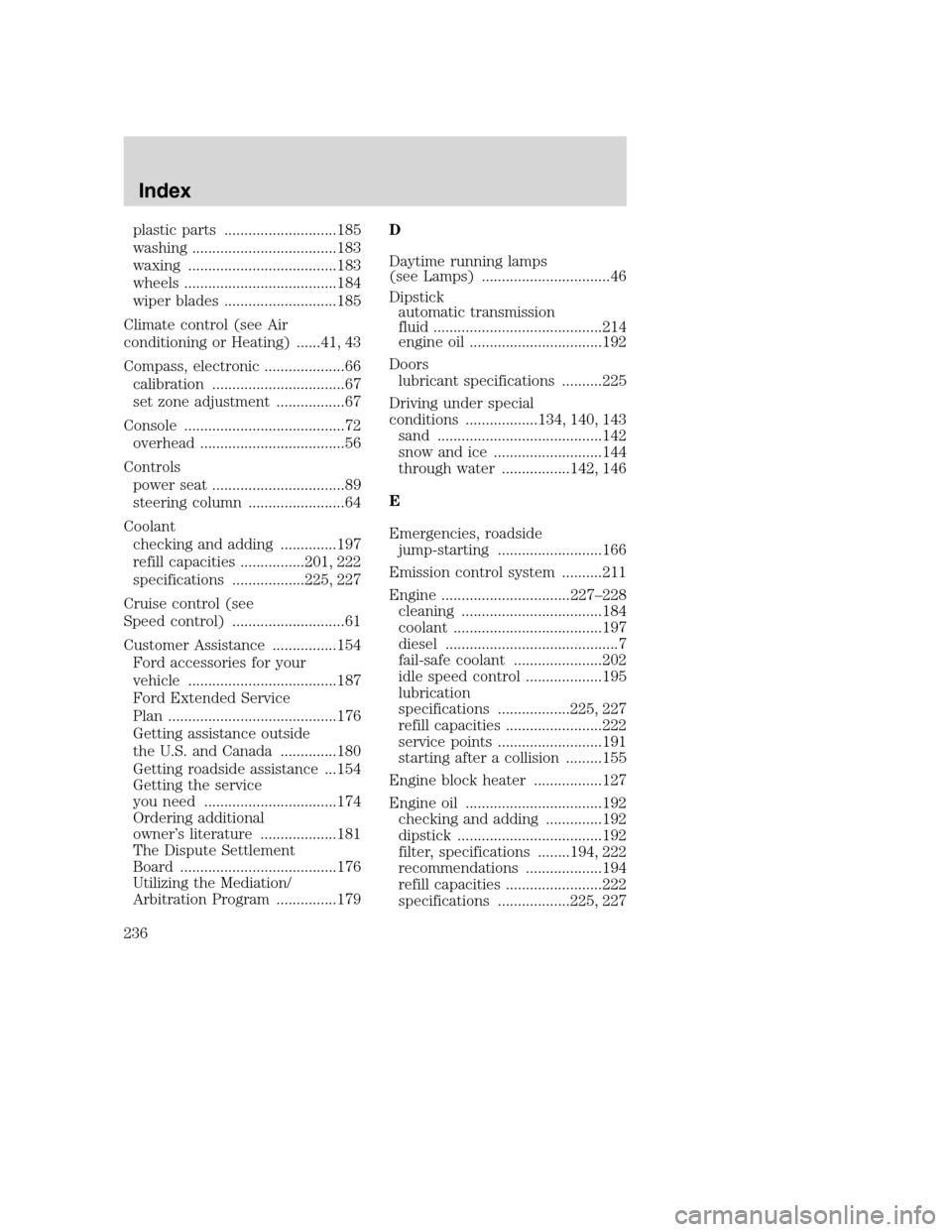
plastic parts ............................185
washing ....................................183
waxing .....................................183
wheels ......................................184
wiper blades ............................185
Climate control (see Air
conditioning or Heating) ......41, 43
Compass, electronic ....................66
calibration .................................67
set zone adjustment .................67
Console ........................................72
overhead ....................................56
Controls
power seat .................................89
steering column ........................64
Coolant
checking and adding ..............197
refill capacities ................201, 222
specifications ..................225, 227
Cruise control (see
Speed control) ............................61
Customer Assistance ................154
Ford accessories for your
vehicle .....................................187
Ford Extended Service
Plan ..........................................176
Getting assistance outside
the U.S. and Canada ..............180
Getting roadside assistance ...154
Getting the service
you need .................................174
Ordering additional
owner’s literature ...................181
The Dispute Settlement
Board .......................................176
Utilizing the Mediation/
Arbitration Program ...............179D
Daytime running lamps
(see Lamps) ................................46
Dipstick
automatic transmission
fluid ..........................................214
engine oil .................................192
Doors
lubricant specifications ..........225
Driving under special
conditions ..................134, 140, 143
sand .........................................142
snow and ice ...........................144
through water .................142, 146
E
Emergencies, roadside
jump-starting ..........................166
Emission control system ..........211
Engine ................................227–228
cleaning ...................................184
coolant .....................................197
diesel ...........................................7
fail-safe coolant ......................202
idle speed control ...................195
lubrication
specifications ..................225, 227
refill capacities ........................222
service points ..........................191
starting after a collision .........155
Engine block heater .................127
Engine oil ..................................192
checking and adding ..............192
dipstick ....................................192
filter, specifications ........194, 222
recommendations ...................194
refill capacities ........................222
specifications ..................225, 227
Index
236
Page 238 of 240
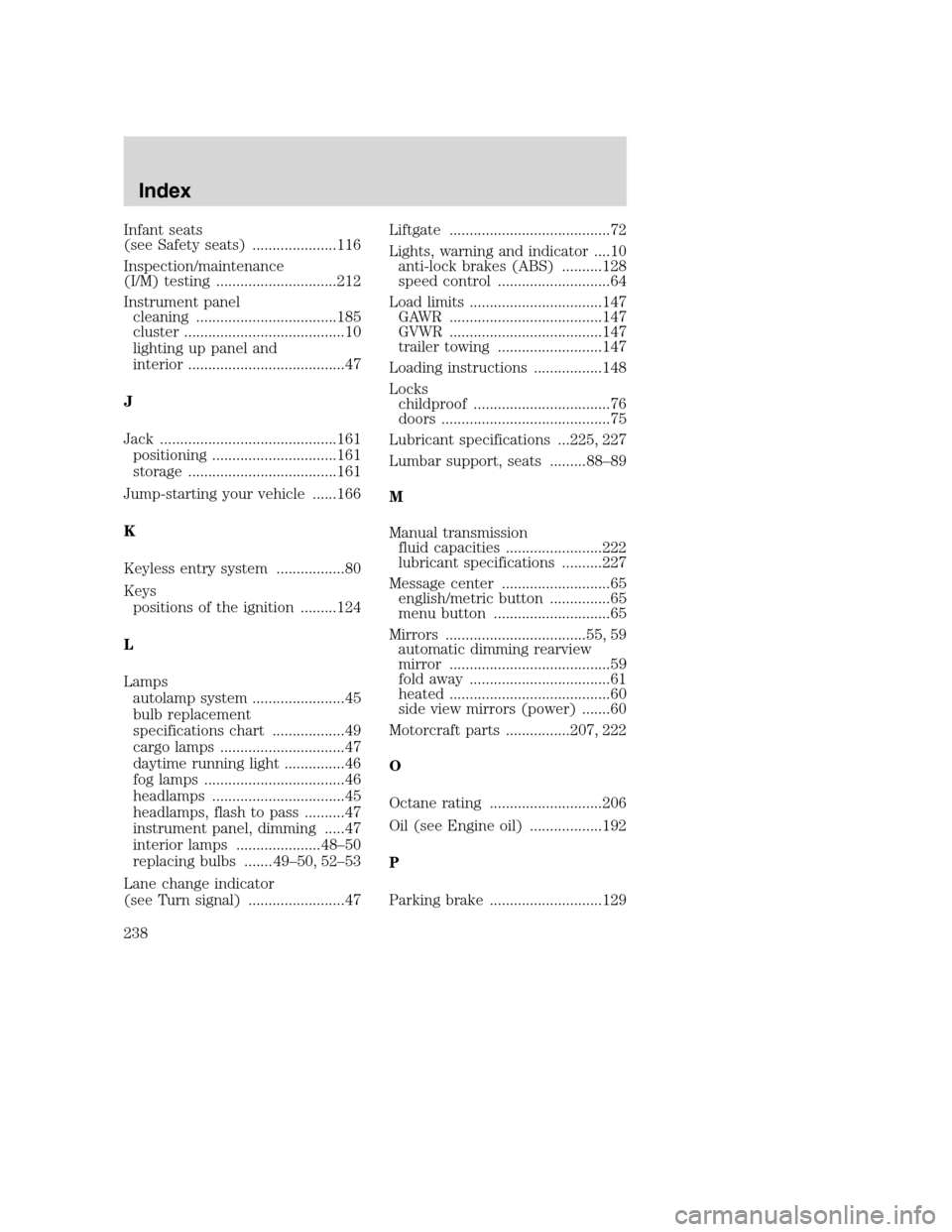
Infant seats
(see Safety seats) .....................116
Inspection/maintenance
(I/M) testing ..............................212
Instrument panel
cleaning ...................................185
cluster ........................................10
lighting up panel and
interior .......................................47
J
Jack ............................................161
positioning ...............................161
storage .....................................161
Jump-starting your vehicle ......166
K
Keyless entry system .................80
Keys
positions of the ignition .........124
L
Lamps
autolamp system .......................45
bulb replacement
specifications chart ..................49
cargo lamps ...............................47
daytime running light ...............46
fog lamps ...................................46
headlamps .................................45
headlamps, flash to pass ..........47
instrument panel, dimming .....47
interior lamps .....................48–50
replacing bulbs ....... 49–50, 52–53
Lane change indicator
(see Turn signal) ........................47Liftgate ........................................72
Lights, warning and indicator ....10
anti-lock brakes (ABS) ..........128
speed control ............................64
Load limits .................................147
GAWR ......................................147
GVWR ......................................147
trailer towing ..........................147
Loading instructions .................148
Locks
childproof ..................................76
doors ..........................................75
Lubricant specifications ...225, 227
Lumbar support, seats .........88–89
M
Manual transmission
fluid capacities ........................222
lubricant specifications ..........227
Message center ...........................65
english/metric button ...............65
menu button .............................65
Mirrors ...................................55, 59
automatic dimming rearview
mirror ........................................59
fold away ...................................61
heated ........................................60
side view mirrors (power) .......60
Motorcraft parts ................207, 222
O
Octane rating ............................206
Oil (see Engine oil) ..................192
P
Parking brake ............................129
Index
238
Page 239 of 240
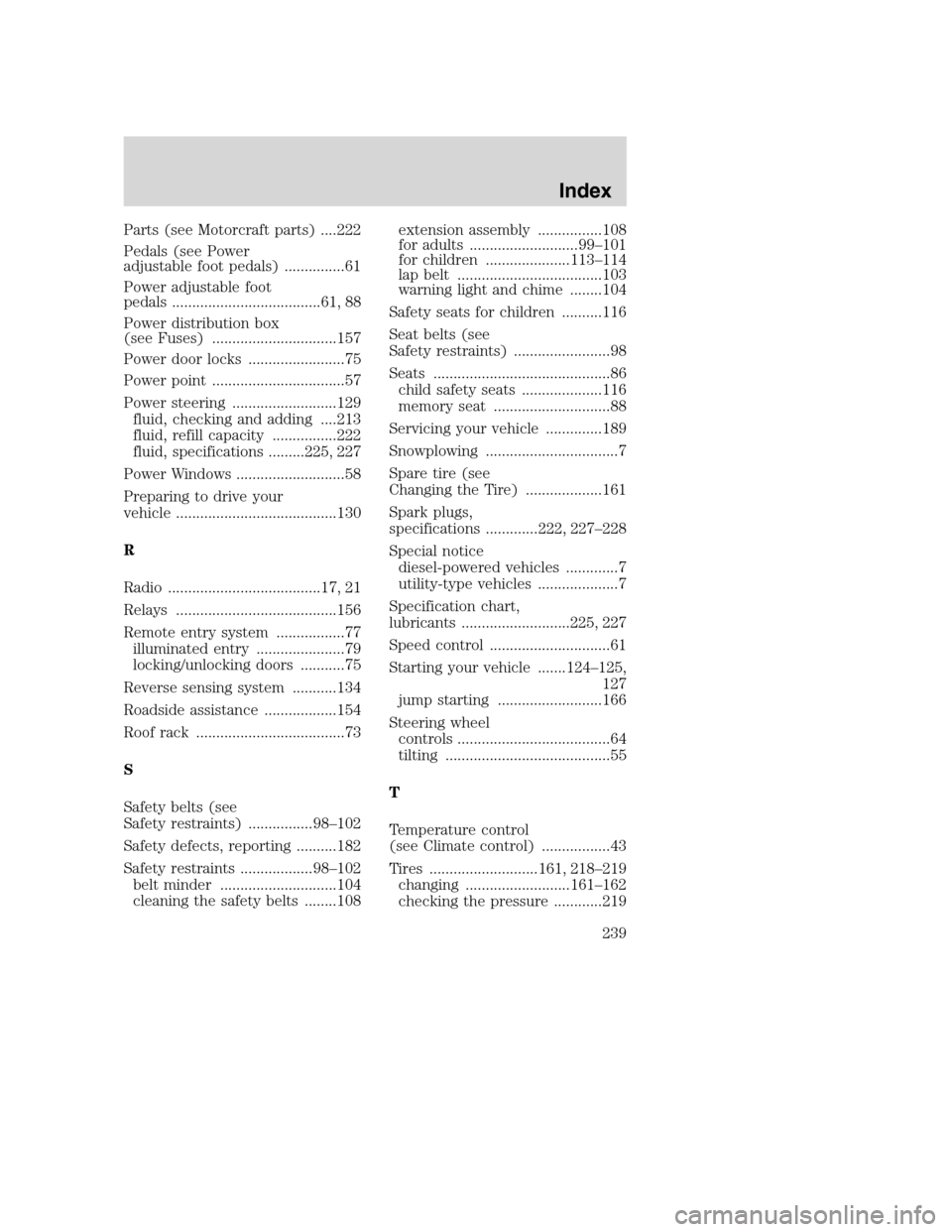
Parts (see Motorcraft parts) ....222
Pedals (see Power
adjustable foot pedals) ...............61
Power adjustable foot
pedals .....................................61, 88
Power distribution box
(see Fuses) ...............................157
Power door locks ........................75
Power point .................................57
Power steering ..........................129
fluid, checking and adding ....213
fluid, refill capacity ................222
fluid, specifications .........225, 227
Power Windows ...........................58
Preparing to drive your
vehicle ........................................130
R
Radio ......................................17, 21
Relays ........................................156
Remote entry system .................77
illuminated entry ......................79
locking/unlocking doors ...........75
Reverse sensing system ...........134
Roadside assistance ..................154
Roof rack .....................................73
S
Safety belts (see
Safety restraints) ................98–102
Safety defects, reporting ..........182
Safety restraints ..................98–102
belt minder .............................104
cleaning the safety belts ........108extension assembly ................108
for adults ...........................99–101
for children .....................113–114
lap belt ....................................103
warning light and chime ........104
Safety seats for children ..........116
Seat belts (see
Safety restraints) ........................98
Seats ............................................86
child safety seats ....................116
memory seat .............................88
Servicing your vehicle ..............189
Snowplowing .................................7
Spare tire (see
Changing the Tire) ...................161
Spark plugs,
specifications .............222, 227–228
Special notice
diesel-powered vehicles .............7
utility-type vehicles ....................7
Specification chart,
lubricants ...........................225, 227
Speed control ..............................61
Starting your vehicle .......124–125,
127
jump starting ..........................166
Steering wheel
controls ......................................64
tilting .........................................55
T
Temperature control
(see Climate control) .................43
Tires ...........................161, 218–219
changing ..........................161–162
checking the pressure ............219
Index
239